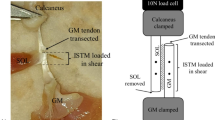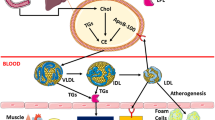Abstract
Purpose of Review
Hypercholesterolemia (HC), or high cholesterol, is usually caused by diet, other health conditions, or inherited diseases, such as familial hypercholesterolemia (FHC). Studies have shown patients with hypercholesterolemia are more prone to tendon injury and impaired healing. Nonetheless, the mechanism by which high cholesterol alters the biochemical and biomechanical properties of tendon and the healing environment is not well defined. This review highlights scientific findings on the relationship between hypercholesterolemia and treatments and tendon pathology at the cellular and tissue level.
Recent Findings
The release of pro-inflammatory cytokines and upregulation of matrix-degrading proteins in hypercholesterolemic conditions leads to an increase in tendon stiffness and elastic modulus. The effect of hypercholesterolemia drugs, such as statins, on tendon pathology remains unclear.
Summary
More insight into the relationship between HC and tendon pathology can lead to improved imaging modalities and therapeutics for tendinopathy in hypercholesterolemic patients.
Similar content being viewed by others
References
Papers of particular interest, published recently, have been highlighted as: • Of importance •• Of major importance
•• Soslowsky LJ, Fryhofer GW. Tendon homeostasis in hypercholesterolemia. Adv Exp Med Biol. 2016:151–65. This review article thoroughly explores the clinical link between tendon pathology and hypercholesterolemia and familial hypercholesterolemia and discusses the mechanisms by which cholesterol-related changes affect tendon health. The article includes future directions for studies on tendon pathology in hypercholesterolemic conditions.
Carroll MD, Kit BK, Lacher DA, Yoon SS. Total and high-density lipoprotein cholesterol in adults: National Health and Nutrition Examination Survey, 2011-2012. NCHS Data Brief 2013.
• Klose G, Laufs U, März W, Windler E. Familial hypercholesterolemia: developments in diagnosis and treatment. Dtsch Arztebl Int. 2014;111(31–32):523–9. This is a review article on the recent and pertinent literature on familial hypercholesterolemia. This article includes insight on the prognosis, the diagnostic findings, and traditional and novel treatments for this particular disease.
Marks D, Thorogood M, Neil HAW, Humphries SE. A review on the diagnosis, natural history, and treatment of familial hypercholesterolaemia. Atherosclerosis [Internet]. 2003;168(1):1–14. Available from: http://www.sciencedirect.com/science/article/pii/S0021915002003301
Goldstein JL BM. Familial Hypercholesterolaemia. Scriver CR et al., editor. New York: McGraw Hill; 1995. 1215–1245 p.
Abifadel M, Varret M, Rabès J-P, Allard D, Ouguerram K, Devillers M, et al. Mutations in PCSK9 cause autosomal dominant hypercholesterolemia. Nat Genet [internet]. 2003;34(2):154–6. Available from: http://www.ncbi.nlm.nih.gov/pubmed/12730697
Goldstein JL, Brown MS. Familial hypercholesterolemia: identification of a defect in the regulation of 3-hydroxy-3-methylglutaryl coenzyme a reductase activity associated with overproduction of cholesterol. Proc Natl Acad Sci U S A [Internet]. 1973;70(10):2804–8. Available from: http://www.pubmedcentral.nih.gov/articlerender.fcgi?artid=427113&tool=pmcentrez&rendertype=abstract
Brown MS, Goldstein JL. M58 a receptor-mediated pathway for cholesterol homeostasis. Science. 1986;232(4746):34–47.
Mombelli G, Pavanello C. Novel therapeutic strategies for the homozygous familial hypercholesterolemia. Recent Pat Cardiovasc Drug Discov. 2013;8(2):143–50.
Suzuki T, Okamoto A. Marked multiple tendinitis at the onset of rheumatoid arthritis in a patient with heterozygous familial hypercholesterolemia: ultrasonographic observation. Case Rep Rheumatol [Internet]. 2014;2014:486348. Available from: http://www.pubmedcentral.nih.gov/articlerender.fcgi?artid=4070418&tool=pmcentrez&rendertype=abstract
Dagistan E, Canan A, Kizildag B, Barut AY. Multiple tendon xanthomas in patient with heterozygous familial hypercholesterolaemia: sonographic and MRI findings. BMJ Case Rep. 2013:1–3.
Langer T, Strober W, Levy RI. The metabolism of low density lipoprotein in familial type II hyperlipoproteinemia. J Clin Invest. 1972.
Mensink RP, Katan MB. Effect of dietary trans fatty acids on high-density and low-density lipoprotein cholesterol levels in healthy subjects. N Engl J Med. 1990.
Glueck CJLR. Acute tendinitis and arthritis type II hyperlipoproteinemia. A presenting symptom of familial type II hyperlipoproteinemia. JAMA. 1968;206(13):2895–7.
Kedar E, Gardner GC. Lipid-associated rheumatologic syndromes. Rheum Dis Clin North Am [Internet]. 2013;39(2):481–93. https://doi.org/10.1016/j.rdc.2013.02.014.
Tsouli SG, Kiortsis DN, Argyropoulou MI, Mikhailidis DP, Elisaf MS. Pathogenesis, detection and treatment of Achilles tendon xanthomas. Eur J Clin Invest. 2005;35:236–44.
Mabuchi H, Ito S, Haba T, Ueda KUR. Discrimination of familial hypercholesterolemia and secondary hypercholesterolemia by Achilles’ tendon thickness. Atherosclerosis. 1977;28:61–8.
Myant NBSJ. Type II hyperlipoproteinaemia. Endocrinol Metab. 1973;2:81–109.
Lakey WC, Greyshock N, Guyton JR. Adverse reactions of Achilles tendon xanthomas in three hypercholesterolemic patients after treatment intensification with niacin and bile acid sequestrants. J Clin Lipidol [Internet]. 2013;7(2):178–81. https://doi.org/10.1016/j.jacl.2012.11.002.
• Nielsen MH, Irvine H, Vedel S, Raungaard B, Beck-Nielsen H, Handberg A. Elevated atherosclerosis-related gene expression, monocyte activation and microparticle-release are related to increased lipoprotein-associated oxidative stress in familial hypercholesterolemia. PLoS One. 2015;10(4):1–19. The aim of the work was to investigate the effect of elevated oxidized LDL cholesterol on the release of pro-inflammatory monocytes and monocyte-derived microparticles (MMPs). Blood samples were collected from patients with familial hypercholesterolemia with or without xanthomas and monocytes classification and MMPs analysis was performed by flow cytometry. The conclusions were that lipoprotein-associated oxidative stress was involved in accelerated familial hypercholesterolemia and xanthomas formation.
Riley GP, Curry V, DeGroot J, Van El B, Verzijl N, Hazleman BL, et al. Matrix metalloproteinase activities and their relationship with collagen remodelling in tendon pathology. Matrix Biol. 2002;21(2):185–95.
Ronnemaa T, Juva K, Kulonen E. Effect of hyperlipidemic rat serum on the synthesis of collagen by chick embryo fibroblasts. Atherosclerosis. 1975;21(3):315–24.
Abate M, Schiavone C, Salini V, Andia I. Occurrence of tendon pathologies in metabolic disorders. Rheumatol (United Kingdom). 2013;52(4):599–608.
Artieda M, Cenarro A, Junquera C, Lasierra P, Martínez-Lorenzo MJ, Pocoví M, et al. Tendon xanthomas in familial hypercholesterolemia are associated with a differential inflammatory response of macrophages to oxidized LDL. FEBS Lett. 2005;579(20):4503–12.
Parkinson J, Samiric T, Ilic MZ, Cook J, Handley CJ. Involvement of proteoglycans in tendinopathy. J Musculoskelet Neuronal Interact. 2011;11:86–93.
Beason DP, Abboud JA, Kuntz AF, Bassora R, Soslowsky LJ. Cumulative effects of hypercholesterolemia on tendon biomechanics in a mouse model. J Orthop Res. 2011;29(3):380–3.
Beason D, Abboud J, Bassora A, Kuntz A SL. Hypercholesterolemia is detrimental to tendon properties and healing in a mouse injury model. Trans Orthop Res Soc. 2009;1418.
Beason DP, Hsu JE, Marshall SM, McDaniel AL, Temel RE, Abboud JA, et al. Hypercholesterolemia increases supraspinatus tendon stiffness and elastic modulus across multiple species. J Shoulder Elb Surg. 2013;22(5):681–6.
Beason D, Kuntz A, Hamamdzic R, Mohler EAJ. High cholesterol adversely affects biceps tendon mechanical properties in a porcine model. Trans Orthop Res Soc. 2009;184.
• Beason DP, Tucker JJ, Lee CS, Edelstein L, Abboud JA, Soslowsky LJ. Rat rotator cuff tendon-to-bone healing properties are adversely affected by hypercholesterolemia. J Shoulder Elb Surg. 2014;23(6):867–72. Clinical data has linked hypercholesterolemia to full-thickness rotator cuff tears and experimental data has shown the effect of high cholesterol on native tendon properties in multiple species. Unilateral supraspinatus detachment and repair surgery was performed on rats with and without high cholesterol and biomechanical testing and histology was performed to determine the cellular and tissue response to hypercholesterolemic conditions. The supraspinatus tendons in the hypercholesterolemic rats were significantly reduced in normalized stiffness at 4 weeks post-injury and there were no significant differences in collagen organization, cell shape, or cellularity between groups.
Chaudhury S, Dines JS, Delos D, Warren RF, Voigt C, Rodeo SA. Role of fatty infiltration in the pathophysiology and outcomes of rotator cuff tears. Arthritis Care Res (Hoboken) [internet]. 2012;64(1):76–82. Available from: http://www.ncbi.nlm.nih.gov/pubmed/21770040
Abtahi AM. Factors affecting healing after arthroscopic rotator cuff repair. World J Orthop [Internet]. 2015;6(2):211. Available from: http://www.pubmedcentral.nih.gov/articlerender.fcgi?artid=4363803&tool=pmcentrez&rendertype=abstract%5Cn, http://www.wjgnet.com/2218-5836/full/v6/i2/211.htm
Abboud JA, Kim JS. The effect of hypercholesterolemia on rotator cuff disease. In: Clinical Orthopaedics and Related Research. 2010. p 1493–7.
De Oliveira LP, Vieira CP, Guerra FDR, de Almeida MS, Pimentel ER. Statins induce biochemical changes in the Achilles tendon after chronic treatment. Toxicology. 2013;311(3):162–8.
Tucker JJ, Soslowsky LJ. Effect of simvastatin on rat supraspinatus tendon mechanical and histological properties in a diet-induced hypercholesterolemia model. J Orthop Res. 2016;34(11):2009–15.
Kirchgesner T, Larbi A, Omoumi P, Malghem J, Zamali N, Manelfe J, et al. Drug-induced tendinopathy: from physiology to clinical applications. Joint Bone Spine 2014.
Marie I, Delafenêtre H, Massy N, Thuillez C, Noblet C. Tendinous disorders attributed to statins: a study on ninety-six spontaneous reports in the period 1990–2005 and review of the literature. Arthritis Care Res. 2008.
• Kuzma-Kuzniarska M, Cornell HR, Moneke MC, Carr AJ, Hulley PA. Lovastatin-mediated changes in human tendon cells. J Cell Physiol. 2015;230(10):2543–51. This recent work focuses on the in vitro response of tenocytes to drugs in the statin family. This is the first study to explore tendon-specific effects of statins in human primary tenocytes. The statins used in this study included simvastatin, atorvastatin, and lovastatin. All three drugs reduced cell migration and prolonged exposure to high concentrations of lovastatin-induced changes in cellular cytoskeleton, mRNA levels for matrix proteins, and increased BMP-2 expression.
Savvidou C, Moreno R. Spontaneous distal biceps tendon ruptures: are they related to statin administration? Hand Surg [internet]. 2012;17(2):167–71. Available from: http://www.ncbi.nlm.nih.gov/pubmed/22745079
Contractor T, Beri A, Gardiner JC, Tang X, Dwamena FC. Is statin use associated with tendon rupture? A population-based retrospective cohort analysis. Am J Ther [Internet]. 2015;22(5):377–81. Available from: http://www.scopus.com/inward/record.url?eid=2-s2.0-84941880893&partnerID=tZOtx3y1
Teichtahl AJ, Brady SR, Urquhart DM, Wluka AE, Wang Y, Shaw JE, et al. Statins and tendinopathy: a systematic review. Med J Aust. 2016;204(3):115–22.
Lin TT-L, Lin C-H, Chang C-L, Chi C-H, Chang S-T, Sheu WH-H. The effect of diabetes, hyperlipidemia, and statins on the development of rotator cuff disease: a nationwide, 11-year, longitudinal, population-based follow-up study. Am J Sports Med [Internet]. 2015;43(9):2126–32. Available from: http://ajs.sagepub.com/content/early/2015/06/17/0363546515588173.full
Schweitzer ME, Karasick D. MR imaging of disorders of the Achilles tendon. Am J Roentgenol. 2000;175(3):613–25.
Michikura M, Ogura M, Yamamoto M, Sekimoto M, Fuke C, Hori M, et al. Achilles tendon ultrasonography for diagnosis of familial hypercholesterolemia among Japanese subjects. Circ J 2017.
Reina D, Jericó C, Estrada P, Navarro V, Torrente V, Armario P, et al. Ecografía en el diagnóstico y manejo de los xantomas tendinosos en la hipercolesterolemia familiar. Reumatol Clínica. 2017.
Abate M, Schiavone C, Salini V, Andia I. Occurrence of tendon pathologies in metabolic disorders. Rheumatology. 2013;52(4):599–608.
Raal FJ, Santos RD. Homozygous familial hypercholesterolemia: current perspectives on diagnosis and treatment. 2012.
Kroon AA, van’t Hof MA, Demacker PN, Stalenhoef AF. The rebound of lipoproteins after LDL-apheresis. kinetics and estimation of mean lipoprotein levels. Atherosclerosis. 2000;152(2):519–26.
•• Arca M. Old challenges and new opportunities in the clinical management of heterozygous familial hypercholesterolemia (HeFH): the promises of PCSK9 inhibitors. Atherosclerosis. 2017;256:134–45. The monoclonal antibodies against serine protease proprotein convertase subtillisin-kexin type 9 (PCSK9) is new drug that has the potential to reduce lipoprotein cholesterol (LDL-C) levels by 50% - 60% when combined with standard lipid-lowering drugs. This review article highlights the use of this novel treatment for patients with heterozygous familial hypercholesterolemia and defines the positive outcomes.
Vuorio A, Tikkanen MJ, Kovanen PT. Inhibition of hepatic microsomal triglyceride transfer protein—a novel therapeutic option for treatment of homozygous familial hypercholesterolemia. Vasc Health Risk Manag. 2014;10:263–70.
Wong E, Goldberg T. Mipomersen (kynamro): a novel antisense oligonucleotide inhibitor for the management of homozygous familial hypercholesterolemia. P T. 2014;39(2):119–22.
•• Bea AM, Perez-Calahorra S, Marco-Benedi V, Lamiquiz-Moneo I, Jarauta E, Mateo-Gallego R, et al. Effect of intensive LDL cholesterol lowering with PCSK9 monoclonal antibodies on tendon xanthoma regression in familial hypercholesterolemia. Atherosclerosis. 2017;263:92–6. This is the first study on the effect of lipoprotein cholesterol lowering effects of PCSK9, alirocumab and evolocumab on tendon xanthomas. The concluding results suggest that PCSK9 is efficient in reducing lipid deposits in the tendons of patients with heterozygous familial hypercholesterolemia when used in combination with standard statin treatments.
Weinreich M, Frishman WH. Antihyperlipidemic therapies targeting PCSK9. Cardiol Rev. 2014;22(3):140–6.
Moroney PJ, Besse JL. Resection of bilateral massive Achilles tendon xanthomata with reconstruction using a flexor hallucis longus tendon transfer and Bosworth turndown flap: a case report and literature review. Foot Ankle Surg [Internet]. 2012;18(3):e20–3. https://doi.org/10.1016/j.fas.2012.03.004.
Author information
Authors and Affiliations
Corresponding author
Ethics declarations
Conflict of Interest
The authors declare that they have no conflict of interest.
Human and Animal Rights and Informed Consent
This article does not contain any studies with human or animal subjects performed by any of the authors.
Additional information
This article is part of the Topical Collection on Orphan Diseases
Rights and permissions
About this article
Cite this article
Taylor, B., Cheema, A. & Soslowsky, L. Tendon Pathology in Hypercholesterolemia and Familial Hypercholesterolemia. Curr Rheumatol Rep 19, 76 (2017). https://doi.org/10.1007/s11926-017-0704-2
Published:
DOI: https://doi.org/10.1007/s11926-017-0704-2




